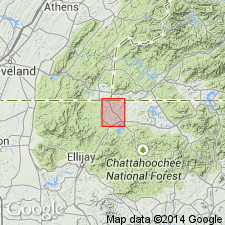
- Usage in publication:
-
- Hughes Gap formation
- Modifications:
-
- Named
- Dominant lithology:
-
- Schist
- Metaconglomerate
- Quartzite
- Metagraywacke
- AAPG geologic province:
-
- Piedmont-Blue Ridge province
Summary:
Named Hughes Gap formation of Great Smoky group for Hughes Gap, Fannin Co., GA where an almost complete section is exposed. Occurs in northernmost GA and southwestern NC. Consists of garnet-mica schist, staurolite schist, metaquartz conglomerate, quartzite, and pseudodiorite with beds of metagraywacke and mica schist near base. Strata range in thickness from a fraction of an inch to more than 50 feet, however, unit is commonly less than 10 feet, with the estimated thickness of the entire unit between 4000 and 6000 feet. The Hughes Gap formation underlies the Hothouse formation and overlies the Copperhill formation with a transition zone of a few hundred feet. Report includes geologic map, correlation chart and extensive mineral analyses. The Hughes Gap is considered of Precambrian age.
Source: GNU records (USGS DDS-6; Reston GNULEX).
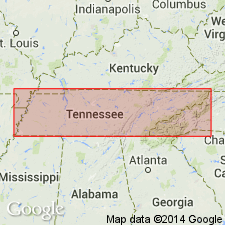
- Usage in publication:
-
- Hughes Gap Formation
- Modifications:
-
- Overview
- AAPG geologic province:
-
- Appalachian basin
Summary:
In Ducktown area of eastern TN, Hughes Gap Formation is included with Copperhill, Hothouse, and Dean Formation in Great Smoky Group, undivided. Age is Precambrian.
Source: GNU records (USGS DDS-6; Reston GNULEX).
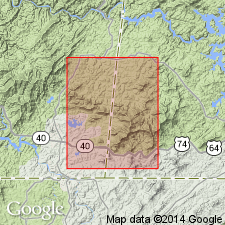
- Usage in publication:
-
- Hughes Gap Formation*
- Modifications:
-
- Revised
- AAPG geologic province:
-
- Piedmont-Blue Ridge province
Summary:
Hughes Gap Formation revised by introduction of newly named Wehutty Formation underlying it. Wehutty is composed of schists, metasandstones, and conglomerate previously assigned to top of Copperhill Formation by Hurst (1955), who considered those lithologies to be a transition zone within Copperhill. Lower contact with Wehutty placed where dark schists (locally graphitic) and phyllites change to light-colored sericitic and muscovitic schists.
Source: GNU records (USGS DDS-6; Reston GNULEX).
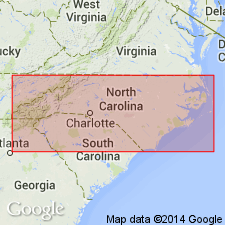
- Usage in publication:
-
- Hughes Gap Formation
- Modifications:
-
- Overview
- AAPG geologic province:
-
- Piedmont-Blue Ridge province
Summary:
Correlation chart (fig. 2) shows the following relations. The Great Smoky Group in western NC consists of five formations (ascending): Thunderhead, Anakeesta, Grassy Branch (new name), Ammons (new name), and Dean Formations (chart implies that Dean and top of Ammons are time equivalent). Grassy Branch Formation is applied to unnamed beds mapped by King and others (1958) above Anakeesta Formation. In relation to Great Smoky Group mapped by Hurst (1955) in Mineral Bluff quad, GA, Anakeesta correlates with Copperhill Formation, Grassy Branch correlates with Hughes Gap Formation, and Ammons correlates with Hothouse and Dean Formations.
Source: GNU records (USGS DDS-6; Reston GNULEX).
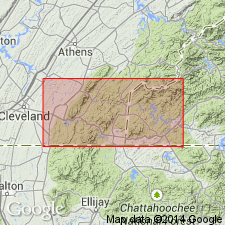
- Usage in publication:
-
- Hughes Gap Formation
- Modifications:
-
- Overview
- AAPG geologic province:
-
- Appalachian basin
Summary:
Hughes Gap Formation correlates with newly named Boyd Gap Formation.
Source: GNU records (USGS DDS-6; Reston GNULEX).
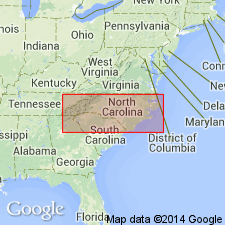
- Usage in publication:
-
- Hughes Gap Formation
- Modifications:
-
- Overview
- AAPG geologic province:
-
- Piedmont-Blue Ridge province
Summary:
Hughes Gap Formation, Hothouse Formation, Grassy Branch Formation, and Horse Branch Member of Ammons Formation are included in undivided unit of metasandstone, metagraywacke, metasiltstone and mica schist unit within Great Smoky Group of Ocoee Supergroup of Late Proterozoic age.
Source: GNU records (USGS DDS-6; Reston GNULEX).
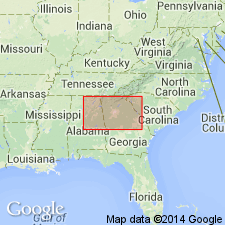
- Usage in publication:
-
- Hughes Gap Formation*
- Modifications:
-
- Overview
- AAPG geologic province:
-
- Piedmont-Blue Ridge province
Summary:
The Hughes Gap Formation of Hurst (1955) of the Great Smoky Group is accepted for USGS use in the Bill Arp thrust sheet in the Murphy synclinorium in northern GA. Age is Late Proterozoic.
Source: GNU records (USGS DDS-6; Reston GNULEX).
For more information, please contact Nancy Stamm, Geologic Names Committee Secretary.
Asterisk (*) indicates published by U.S. Geological Survey authors.
"No current usage" (†) implies that a name has been abandoned or has fallen into disuse. Former usage and, if known, replacement name given in parentheses ( ).
Slash (/) indicates name conflicts with nomenclatural guidelines (CSN, 1933; ACSN, 1961, 1970; NACSN, 1983, 2005, 2021). May be explained within brackets ([ ]).

